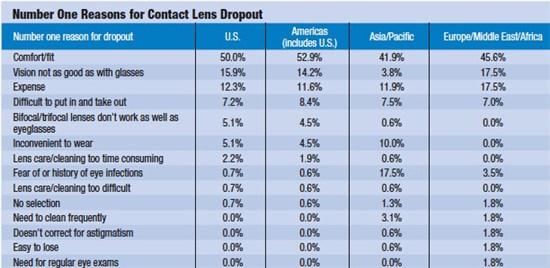 Focus on keeping your contact lens patients’ eyes both healthy and comfortable–if you don’t want them to dropout. If they do dropout it is unlikely they will give contact lenses another try, according to Jobson Research’s latest Contact Lens Insight Survey. Discomfort (40.8 percent) was the most frequently stated reason that people stopped wearing contact lenses. Some 72.3 percent of respondents said they will “probably not” or “definitely not” return to wearing contact lenses. Of those who are “very” or “fairly” likely to return to wearing contact lenses in the future, 30.1 percent say they will probably do so within the next six months. Of those who don’t currently wear contact lenses but have worn them in the past, 5.8 percent “will probably” or “will definitely” have vision correction surgery in the future. More than eight out of ten (82.6 percent) of respondents who do not currently wear contact lenses but have worn them in the past stopped wearing contact lenses more than three years ago.
Focus on keeping your contact lens patients’ eyes both healthy and comfortable–if you don’t want them to dropout. If they do dropout it is unlikely they will give contact lenses another try, according to Jobson Research’s latest Contact Lens Insight Survey. Discomfort (40.8 percent) was the most frequently stated reason that people stopped wearing contact lenses. Some 72.3 percent of respondents said they will “probably not” or “definitely not” return to wearing contact lenses. Of those who are “very” or “fairly” likely to return to wearing contact lenses in the future, 30.1 percent say they will probably do so within the next six months. Of those who don’t currently wear contact lenses but have worn them in the past, 5.8 percent “will probably” or “will definitely” have vision correction surgery in the future. More than eight out of ten (82.6 percent) of respondents who do not currently wear contact lenses but have worn them in the past stopped wearing contact lenses more than three years ago.
The current Jobson data show this problem is consistent over time.Here’s data from the 1/15/2010 issue of Review of Optometry.
New Data on Contact Lens Dropouts: An International Perspective
John Rumpakis, OD, MBA

The number one reason for contact lens dropout continues to be comfort. Second place is a distant second place. Clearly, comfort is the key issue we need to make sure is handled to keep patients in contact lenses.
There are at least three action plans we can put in place today to address this issue.
1. Better identify “at risk” patients.
We need to ask better history questions to better identify our “at risk” patients. Consider adding this question to your pre-examination history questionnaire: “Is there any time of day when your contact lenses are less comfortable?”
2. Prescribe the most current contact lenses.
Contact lens manufacturers are very aware of the comfort problem and are working very hard to develop lenses that are more comfortable over longer times. Don’t just keep a patient in a contact lens because they have always done relatively well in that contact lens. Make sure you are updating the patient’s prescription to newer lenses to give your patients the advantage of the new technologies and, therefore, better comfort.
3. Manage our recall systems better so we can do #1 and #2 above sooner rather than later.
The average return for a contact lens patient in a traditional recall system is 18 months even though we told them to return in 12 months. (And the number one reason for the return is the patient is out of lenses. Obviously, patients are over-wearing their contact lenses.) Seventy-five percent of contact lens patients who are pre-appointed will return within 15 months instead of 18 months. If you are not pre-appointing, start today.
Keeping patients in contact lenses is something every practice should view as important. Start today with the three steps listed above.





















